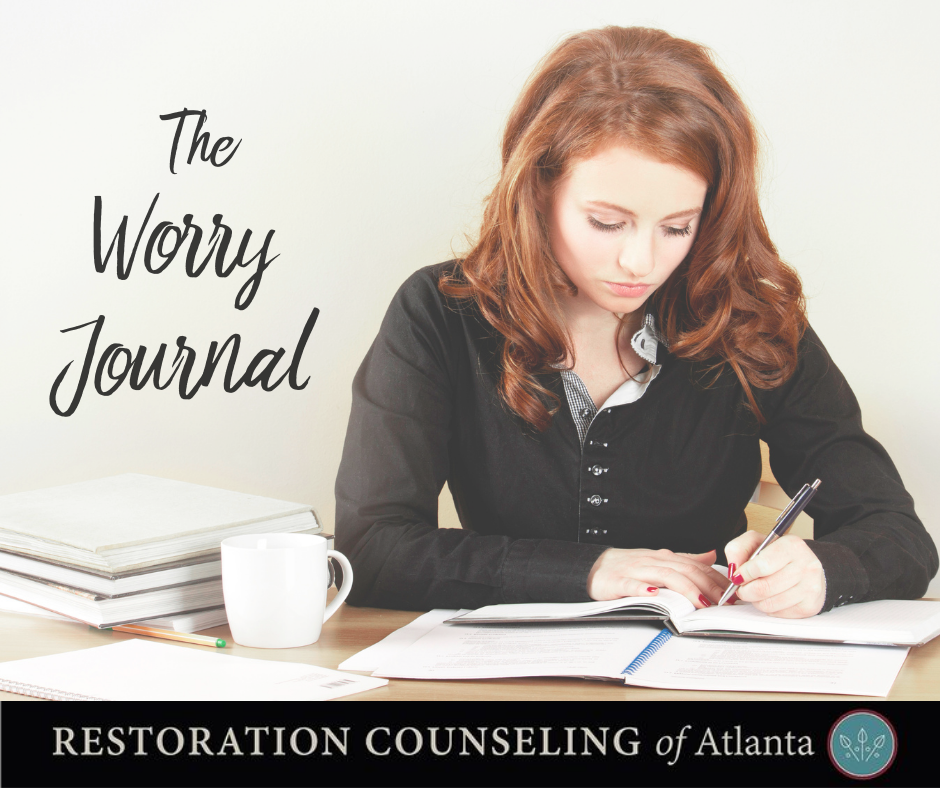We’ve all been there – tossing and turning a couple of hours after your head hits the pillow, but the racing and ruminative thoughts running through your mind just won’t let you rest. Should you give in to these thoughts and forgo sleep to satisfy their urgings or should you keep trying to ignore them and get some much-needed sleep?
Such worry can feed feelings of anxiety, stress, and fear. It can lead to catastrophizing. It can cause overthinking of even the most seemingly straightforward circumstance and can even trigger panic.
The worry journal is a tool that can help with insomnia, racing thoughts, rumination, and other stressed-out moments, whether it be at bedtime or any other time during the day.
Racing Thoughts
Racing thoughts are fast moving and often repetitive thought patterns that can be overwhelming. They may focus on a single topic, or they may represent multiple different lines of thought. You may experience racing thoughts about anything – a financial issue, an embarrassing moment, or a phobia. These thoughts also tend to escalate.
Racing thoughts can increase your anxiety or feelings of unease and can disrupt your concentration. It can lead to feelings of helplessness because they feel out of your control and that your problems are too big for you to manage.
Rumination
Rumination is when your head is filled with one single thought, or a string of thoughts, that just keep repeating… and repeating… and repeating themselves.
Rumination can be dangerous to your mental health because it can prolong or intensify depression (ruminative thoughts are usually not about happy things but instead are sad or dark) and can impair your ability to think and process emotions. It may also push people away and lead to feelings of isolation.
Frequent reasons for rumination include:
- the belief that by ruminating, you’ll gain insight into your life or a problem,
- having a history of emotional or physical trauma, and
- facing ongoing stressors that can’t be controlled.
Ruminating is also common in people who possess certain personality characteristics, such as perfectionism, neuroticism, and an excessive focus on interpersonal relationships.
According to Ryan Howes, “While rumination isn’t its own diagnosis, it is unique in that it can be a symptom of both depression and anxiety. The depressed person dwells on losses and missteps from the past, while the anxious ruminator drowns in a sea of “what if” questions, forever envisioning the negative outcome. Whether it’s what we can’t change or can’t predict, sometimes our brains get stuck trying to control the uncontrollable.”
What is a Worry Journal?
A worry journal is an effective self-care practice that can help manage stress and anxiety by letting you focus on your worries, then literally close the book on them.
It might seem strange to give these thoughts more time in the spotlight, but by journaling or listing intrusive and worrisome thoughts, you actually lessen the overall time spent focusing on them. Having a notepad handy to jot down the thoughts and worries that are on repeat allows you to acknowledge them (your anxiety wants you to pay attention to them), capture them on paper (which tells your anxiety to quiet down since you won’t forget the thoughts), and gives you a needed release from them as you refocus on the task at hand.
Using a worry journal to jot down your stresses and anxieties can also be an effective tool to help you lean into uncomfortable emotions. It can build your understanding of what you’re feeling and provide you with a path forward by moving you into a different headspace, one that isn’t consumed with overthinking. This newfound clarity may assist you in organizing your thoughts to find simple steps toward a solution that you can act on.
How Does a Worry Journal Help?
You may discover that simply writing out your worries makes them feel less heavy or scary or realize that some anxieties were so unrealistic they were never likely to happen. It’s common for worries to appear bigger in your head than they are in reality, so putting them on paper will often change your outlook for the better.
Healthline.com notes that worries can all start fueling each other, merging and making your stress levels rise. Writing down concerns and worries enables you to gain perspective over what are genuine concerns versus hypothetical worries.
In addition to providing perspective, journaling can help you be more attuned to how you’re interpreting things. It can help you process your worries so you can become more aware of the difference between the event and your interpretation of the event. And changing your interpretation allows you to control your responses instead of simply falling into anxious patterns.
How Do I Start a Worry Journal?
According to an article in Health.com, “to break the [worry] cycle, sleep experts recommend dealing with worrisome issues during the day, often by writing them down. Joyce Walsleben, Ph.D., associate professor at New York University School of Medicine, gives the tips below.
- Designate a notebook as your worry journal.
- Spend about half an hour with your worry book every afternoon or evening, several hours before bedtime.
- List bothersome issues on the left side of the page.
- Think about what you can do to help resolve these issues and write your plans on the right side of the page.
- Close the book, put it out of sight, and don’t think about these issues until the following day.”
Another idea from Alexa Erikson at shape.com suggests getting started by dividing your notebook into different sections. Designate different pages or columns that are meant for things you “need to take care of,” things you “can’t forget to do,” and things you’re “so worried about.” Write down all your thoughts or worries that fall into these categories. Make sure to leave space for problem-solving ideas.
Whatever your approach, be careful not to judge your worries as that may lead to censoring yourself which could allow you to avoid dealing with the true source of them. Instead, think of your worry journal as a private, safe space to express anything on your mind.
The hope is that by putting thoughts on paper, you will be able to change your perspective on them, come up with useful solutions, or at least get out some of the feeling weighing you down.
Incorporate Gratitude
If you are journaling just before lights out and find that you’re either not getting the relief you seek or getting more anxious about your captured worries, wrap up your journaling session with a gratitude list.
To do this, focus your mind on what you are thankful for. This can be anything that is positive: big or small, people or things, occurrences that happened or what you’re grateful that did not happen. Changing your focus to more positive things helps you release built-up stress and tension, allowing you to relax and rest better.
Practice Acceptance
In reality, some problems that consume your thoughts cannot be solved, either at all or just at this point in time, and a worry journal will not find a magical answer to these. In these situations, you must practice acceptance.
Tell yourself that these unsolvable problems aren’t your concern. When you find yourself thinking about them, acknowledge your concern, then tell yourself it is OK to let it be, that you don’t have to act on your worry. If the thought resurfaces, acknowledge it again and accept it for what it is.
After enough practice, your mind will be better at quickly moving away from nagging thoughts.
Breaking a worrying habit will take time!
Be patient with yourself as you change hard patterns and remember that YOU are in charge, not your worry. Make a blanket rule to interrupt your unneeded thoughts whenever they come up, and plan ahead for a positive thought to switch to. Even if the switch is simply to return attention to the task at hand, you make the decision to change ruminative and worrying thoughts.
By interrupting and replacing anxious thoughts every time it’s needed, even if that means hundreds of times a day, you will stop them.
 by Paige Santmyer, MA APC NCC CCATP
by Paige Santmyer, MA APC NCC CCATP
Roswell location
paige@restorationcounselingatl.com, ext. 157
Paige provides a safe and comfortable atmosphere where clients can explore the challenges they are facing. She also believes in addressing the individual’s entire personhood, assessing needs in all domains of life instead of focusing solely on mental health needs. Paige works with adults and teens around depression, anxiety, mood disorders, relationship issues, trauma, PTSD, and life transitions.
References
- Belsky, G. (February 29, 2016). How to start a worry journal: Learning to handle stress and sleep soundly. Retrieved from: https://www.health.com/condition/sleep/how-to-start-a-worry-journal-learning-to-handle-stress-and-sleep-soundly
- Cirino, E. (April 18, 2019). How to stop ruminating. Retrieved from: https://www.healthline.com/health/how-to-stop-ruminating
- Erickson, A. (February 23, 2017). All the ways a worry journal could make your life better: From reducing stress and anxiety to getting a better night’s sleep, pen to paper can be a genius solution. Retrieved from: https://www.shape.com/lifestyle/mind-and-body/worry-journal-mental-health-benefits
- Gotter, A. (December 5, 2019). Racing thoughts: What to do when your mind is racing. Retrieved from: https://www.healthline.com/health/racing-thoughts
- Howes, R. (January 11, 2019). How to stop overthinking everything.
Retrieved from: https://www.buzzfeed.com/ryanhowes/how-to-stop-ruminating - The Recovery Village. (August 5, 2021) How to stop ruminating. Retrieved from: https://www.therecoveryvillage.com/mental-health/rumination/how-to-stop-ruminating/
- Stokes, V. (December 16, 2020). Can a worry journal help you manage stress? Retrieved from: https://www.healthline.com/health/stress/can-a-worry-journal-help-you-manage-stress#experts

